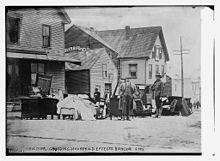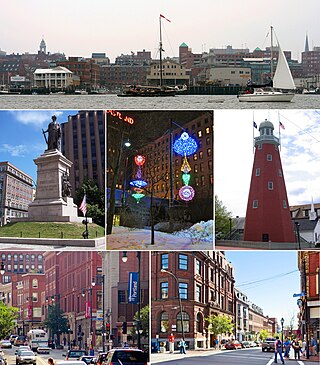


The Great Fire of 1911 took place in Bangor, Maine, United States, on April 30 and May 1, 1911. A small fire that started in a downtown shed went out of control and destroyed hundreds of commercial and residential buildings.



The Great Fire of 1911 took place in Bangor, Maine, United States, on April 30 and May 1, 1911. A small fire that started in a downtown shed went out of control and destroyed hundreds of commercial and residential buildings.
It started in the afternoon of April 30, 1911, on Broad Street. High winds had spread it to a shed on Exchange Street and the Universalist Church on Center Street by 4:10 PM, from where it spread into the residential neighborhood on Center Street Hill. In 1907, the National Board of Fire Underwriters had mapped the fire geography of Bangor, and predicted that a large fire could have spread from that area. [1]
The fire eventually became so large that the glow in the sky could be seen in Belfast. It was brought under control on Monday morning, May 1, 1911, but before it was out, it destroyed much of Downtown Bangor. The Post Office, the Custom House, and Norumbega Hall were lost, along with the three buildings of Bangor High School and the Bangor Public Library. Somehow, City Hall survived, despite being in the direct path of the fire. The library's collection of 70,000 volumes was destroyed, along with much of the Bangor Historical Society's collection. An attempt to slow the fire by dynamiting buildings in its path failed. A light rain that began overnight did much to bring the fire under control. [2] In total, 285 residences, 100 businesses, and 6 churches were destroyed, doing $3.2 million damage and leaving hundreds homeless. [3] [4] Before the fire, insurance companies had considered Bangor a good risk.[ citation needed ]
Remarkably, only two people died: one Brewer man who was caught in electrical wiring while crossing a bridge, and one firefighter. [5]
Fire crews were called from as far away as Lewiston and Portland. After the telephone company caught fire, the wire chief climbed a pole and cut in on a trunk line to make aid calls. [6] One team that was sent up from Boston, Massachusetts, ended up fighting a fire in Portland when their train stopped there. [7]
The area destroyed by the fire was quickly rebuilt, with many architectural commissions going to New York and Boston firms (such as Carrere and Hastings and Peabody and Stearns), as well as local designers Wilfred E. Mansur, C. Parker Crowell, and Victor Hodgins. A large portion of the rebuilt area (43 buildings) was listed on the National Register of Historic Places in 1984 as the Great Fire of 1911 Historic District.

Portland is a port city and the most populous city in the U.S. state of Maine and the seat of Cumberland County. Portland's population was 68,408 in April 2020. The Greater Portland metropolitan area is home to over half a million people, the 104th-largest metropolitan area in the United States. Historically tied to commercial shipping, the marine economy, and light industry, Portland's economy in the 21st-century relies mostly on the service sector and tourism. The Old Port is a prominent neighborhood known for its nightlife and 19th-century architecture. Despite the economic shift, the Port of Portland was still the second-largest tonnage seaport in New England as of 2019.

Bangor is a city in and the county seat of Penobscot County, Maine, United States. The city proper has a population of 31,753, making it the state's third-most populous city, behind Portland (68,408) and Lewiston (37,121). Bangor is known as the “Queen City.”

Michael Herman Michaud is an American businessman and politician from Maine. Michaud served as the U.S. representative for Maine's 2nd congressional district from 2003 to 2015. He is a member of the Democratic Party. The primarily rural district comprises nearly 80% of the state by area and includes the cities of Lewiston, Auburn, Bangor, Presque Isle, and Ellsworth. It is the largest Congressional district by area east of the Mississippi River.

The University of Southern Maine (USM) is a public university with campuses in Portland, Gorham and Lewiston in the U.S. state of Maine. It is the southernmost of the University of Maine System. It was founded as two separate state universities, Gorham Normal School and Portland University. The two universities, later known as Gorham State College and the University of Maine at Portland, were combined in 1970 to help streamline the public university system in Maine and eventually expanded by adding the Lewiston campus in 1988.

Chellie MariePingree is an American politician serving as the U.S. representative for Maine's 1st congressional district since 2009. Her district includes most of the southern part of the state, including Portland and Augusta.

Northeast Harbor is a village on Mount Desert Island, located in the town of Mount Desert in Hancock County, Maine, United States.

The Valentine Phantom, often referred to as the Valentine Bandit in media reports, refers to an unidentified individual or group who each Valentine's Day secretly decorate the downtown area of a city in the United States with a series of red hearts printed on sheets of letter-sized paper.
Bangor High School, a member of the Bangor School System, is a high school in Bangor, Maine, United States. It has an enrollment of approximately 1,200 students in grades 9–12.


The History of Portland, Maine begins when the area was called Machigonne, meaning "great neck," by Algonquians who originally inhabited the peninsula. It extends to the city's recent cultural and economic renaissance.
There are a number of wind power projects in the state of Maine, totaling more than 900 megawatts (MW) in capacity. In 2020 they were responsible for 24% of in-state electricity production. In 2019, Maine had more wind capacity than the other five New England states combined, at 923 MW.
Portland, Maine, is home to many neighborhoods.

The Great Fire of 1911 Historic District is located in downtown Bangor, Maine, and has been listed on the National Register of Historic Places since 1984. It preserves Maine's most significant collection of early 20th century public and commercial buildings, and commemorates an urban re-building campaign matched only by Portland's following its own destruction by fire in 1866. The Great Fire of 1911 was Maine's last large-scale urban conflagrations, but resulted in the creation of an early 20th-century urban space relatively unique in Maine or northern New England.
Wilfred E. Mansur (1855–1921) was the most prominent architect in late 19th and early 20th century Bangor, Maine.
Jews have been living in Maine, a state in the northeastern United States, for 200 years, with significant Jewish communities in Bangor as early as the 1840s and in Portland since the 1880s. The arrival of Susman Abrams in 1785 was followed by a history of immigration and settlement that parallels the history of Jewish immigration to the United States.

68 High Street, formerly the Children's Hospital, is a historic colonial revival building in Portland, Maine. Located on the eastern edge of Portland's West End, the building was built in 1909 and was designed by architect Frederick A. Tompson. According to news archives, Drs. Edville Gerhardt Abbott and Harold A. Pingree and Frank W. Lamb founded this worldwide famous children's hospital for disabled children with scoliosis together in 1908. It closed in 1948, with most of the 56 patients at the time being transferred to Maine General Hospital, which was later renamed the Maine Medical Center. It also served as an annex to the Mussey Mansion until the left part of that building was demolished in 1961. It was also owned by the University of Maine system. It housed the University of Maine School of Law from 1962? until 1972, after which was used by the University of Southern Maine as administrative offices.

C. Parker Crowell (1876–1959) was an American architect in practice in Bangor, Maine, from 1902 until his retirement in 1956. Crowell and his firm would design over 1000 buildings in the course of his career. The firm Crowell co-founded is still in business as WBRC.

The Graham Building is a yellow-brick Romanesque Revival style commercial building in downtown Bangor, Maine, at the corner of Harlow and Central Streets. It is one of the most prominent buildings in the Great Fire of 1911 Historic District, which is listed on the National Register of Historic Places.

Great Northern Paper Company was a Maine-based pulp and paper manufacturer that at its peak in the 1970s and 1980s operated mills in Arkansas, Georgia, Maine, and Wisconsin and produced 16.4% of the newsprint made in the United States. It was also one of the largest landowners in the state of Maine.

On the morning of March 29, 1911, a fire destroyed substantial portions of the New York State Capitol, including vast holdings of the New York State Library and the New York State Museum. It destroyed or damaged hundreds of thousands of documents and books. There was one casualty, Samuel Abbott, a watchman.